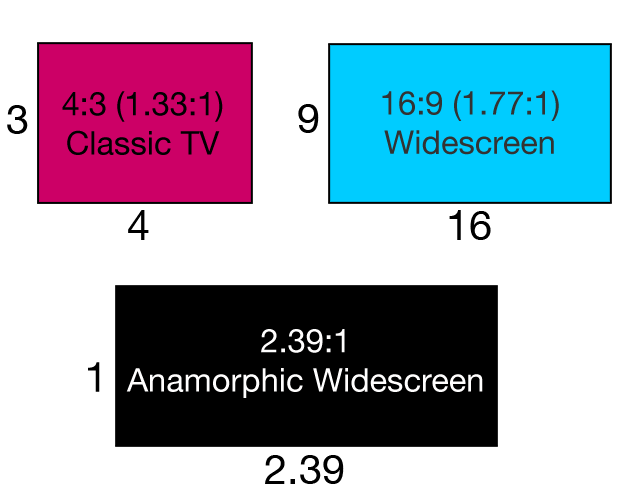When it comes to buying a new TV, there are various terms and specifications out there that can often confuse the average consumer. Often times, walking into a store will have you running into sales associate that will want to sell you on the newest (and most expensive) tv on the market. Before going in blindly, you should at least know the difference between popular buying terms for television sets and how you can determine which type of TV you’re looking for.
For those who have trouble deciphering between LCD and LED, while trying to figure out if you need a Smart TV or not, it’s time to be prepared before you upgrade your next TV set with our guide to all the TV buying terms:
Aspect Ratio

Source: Vimeo
Generally, when we talk about aspect ratios, it’s the ratio between the horizontal and vertical lengths of a television screen. For example, your old square TV from the ‘90s might have been a 4:3 ratio, which is often not available now. The more common high-definition TVs (HDTV) will have a 16:9 ratio, but if you’re looking for a more cinematic viewing, then you can upgrade to the 21:9 ratio.
HD
If you’re in the market for an HDTV, it’s not always as simple as it seems. There are various HDTVs on the market and the difference between them is the resolution, which means the amount of pixels a TV has. When you go up in resolution or pixels, then the picture on your TV will end up looking more clear and defined. Here are examples of the four main HDTVs:
- HD (1280×720)
- FullHD (1920×1080)
- Ultra HD/4K (3840×2160)
- Ultra HD/8K (7620×4380)
While having a higher resolution can be worth it, the higher resolutions might only make a miniscule of different, so bigger is not always better.
Type of TV Sets
Plasma
Plasma screen TVs used to be the biggest TV on the market, but now have been steadily replaced with LCD, LED, and OLED (more on that in a bit). However, plasma screens are often available at an affordable price, if you are on a budget. The main characteristics of a plasma screen include producing a more contrast image, less motion blur, capable of producing wider images, and even brightness levels. However, be careful as plasma screens are notorious for screen burn-in, which provides a discoloration over time.
LCD
LCD stands for “liquid-crystal display” and is a popular flat-panel display screen in the TV market. One of the most notable parts of LCD TVs is that it is a big energy saver as it consume little power to use. LCDs can also produce a razor sharp image without any of the negative side effects of plasma screens, like screen burn-in.
LED
As a “light emitting diode”, LED-lit screens offer a better picture quality than regular LCD that contain fluorescent bulbs. Since more LED TVs are actually LCD TVs with an LED-lit screen, remember to ask whether the screen is lit by fluorescent bulbs or LED. While LED-lit TVs are often superior to regular LCD, it’s often more costly to invest in a LED-lit TV compared to LCD.
OLED
While LED often means a LCD TV lit by LED, OLED means that the screen is lit by LEDs for both light and color. OLED stands for “organic light emitting diode” meaning that it uses carbon-based materials rather than silicon. OLED is superior to LED-lit LCD TVs with its improved contrast image, the thinness of the screen, and it’s improved picture quality. The negative part of OLEDs is that they have a shorter lifespan than other TVs and carry a higher price tag.
Smart TV

Smart TVs are for those who want to stay connected. By having the ability to connect to the Internet and popular apps, smart TVs have their own operating system that have the ability to download apps and use apps similar to your smart phone. If you’re looking for a TV to automatically play you Netflix, this might be the one for you.
3DTV

If you’re wondering if you want to invest in a 3DTV, then it’s important to know the difference between the different type of TV sets. 3D-ready TV sets have a 3D mode on the television that can produce a 3D image with the use of 3D glasses. On the other hand, there are Full 3D TV sets that do not require the 3D glasses. While the trend of 3D might be appealing, there are only a limited amount of 3D channels to watch and can have a higher price tag attached to the set.
If you’re itching to get yourself a brand new TV, then lead on over to our TV & Home Entertainment section for our selection of TV sets!



